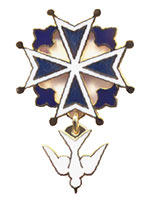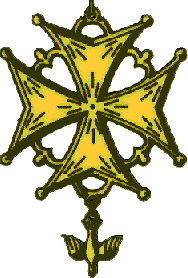
Huguenot cross
Encyclopedia


Huguenot
The Huguenots were members of the Protestant Reformed Church of France during the 16th and 17th centuries. Since the 17th century, people who formerly would have been called Huguenots have instead simply been called French Protestants, a title suggested by their German co-religionists, the...
cross is a Christian
Christianity
Christianity is a monotheistic religion based on the life and teachings of Jesus as presented in canonical gospels and other New Testament writings...
religious symbol originating in France
France
The French Republic , The French Republic , The French Republic , (commonly known as France , is a unitary semi-presidential republic in Western Europe with several overseas territories and islands located on other continents and in the Indian, Pacific, and Atlantic oceans. Metropolitan France...
and is one of the more recognisable and popular symbols of the evangelical
Evangelicalism
Evangelicalism is a Protestant Christian movement which began in Great Britain in the 1730s and gained popularity in the United States during the series of Great Awakenings of the 18th and 19th century.Its key commitments are:...
reformed faith. It is commonly found today as a piece of jewellery (in gold or silver) or engraved on buildings connected with the Reformed Church in France. It also forms part of the official logo
Logo
A logo is a graphic mark or emblem commonly used by commercial enterprises, organizations and even individuals to aid and promote instant public recognition...
of the Reformed Church in France.
It is sometimes asserted that the cross appeared for the first time during the Huguenot Wars (1562-1598) in the South of France. Bertrand Van Ruymbeke asserts instead that the Huguenot cross stands out as "the most revealing" of symbolic signs of latter-day Huguenot solidarity: "Although a Huguenot cross was indeed designed in Nîmes in the 1680s, never was it in France the symbole de reconnaissance it later became for the descendants of the Huguenot refugees in the last third of the nineteenth century" Van Ruymbeke identifies the late 19th-century Huguenot revival as sharing characteristics with two of historian Eric Hobsbawm
Eric Hobsbawm
Eric John Ernest Hobsbawm , CH, FBA, is a British Marxist historian, public intellectual, and author...
's three categories of "invented traditions": A. "those establishing or symbolizing social cohesion or the membership of groups, real or artificial communities", and B. "those whose main purpose [is] socialization, the inculcation of beliefs, value systems and conventions of behavior."
Long after the revocation
Edict of Fontainebleau
The Edict of Fontainebleau was an edict issued by Louis XIV of France, also known as the Revocation of the Edict of Nantes. The Edict of Nantes of 1598, had granted the Huguenots the right to practice their religion without persecution from the state...
of the Edict of Nantes
Edict of Nantes
The Edict of Nantes, issued on 13 April 1598, by Henry IV of France, granted the Calvinist Protestants of France substantial rights in a nation still considered essentially Catholic. In the Edict, Henry aimed primarily to promote civil unity...
, the Huguenot Cross came into general use amongst 19th-century Huguenot descendants in countries where Huguenot refugees settled, as identification with the French Huguenot ancestry, as much as confirmation of the wearer's faith.
In 1942, the Free French Protestants in Great Britain issued a badge that paired the Huguenot cross with the Cross of Lorraine
Cross of Lorraine
The Cross of Lorraine is originally a heraldic cross. The two-barred cross consists of a vertical line crossed by two smaller horizontal bars. In the ancient version, both bars were of the same length. In 20th century use it is "graded" with the upper bar being the shortest...
, which had been taken up by the Free French Forces
Free French Forces
The Free French Forces were French partisans in World War II who decided to continue fighting against the forces of the Axis powers after the surrender of France and subsequent German occupation and, in the case of Vichy France, collaboration with the Germans.-Definition:In many sources, Free...
.
Symbolism
The symbolism of the Huguenot cross is particularly rich.- The crossCrossA cross is a geometrical figure consisting of two lines or bars perpendicular to each other, dividing one or two of the lines in half. The lines usually run vertically and horizontally; if they run obliquely, the design is technically termed a saltire, although the arms of a saltire need not meet...
as an eminent symbol of the Christian faithChristianityChristianity is a monotheistic religion based on the life and teachings of Jesus as presented in canonical gospels and other New Testament writings...
, represents not only the death of ChristChristChrist is the English term for the Greek meaning "the anointed one". It is a translation of the Hebrew , usually transliterated into English as Messiah or Mashiach...
but also victory over death and impiety. This is represented also in the Maltese CrossMaltese crossThe Maltese cross, also known as the Amalfi cross, is identified as the symbol of an order of Christian warriors known as the Knights Hospitaller or Knights of Malta and through them came to be identified with the Mediterranean island of Malta and is one of the National symbols of Malta...
. - It is boutonné, the eight points symbolising the eight BeatitudesBeatitudesIn Christianity, the Beatitudes are a set of teachings by Jesus that appear in the Gospels of Matthew and Luke. The term Beatitude comes from the Latin adjective beatus which means happy, fortunate, or blissful....
(MatthewGospel of MatthewThe Gospel According to Matthew is one of the four canonical gospels, one of the three synoptic gospels, and the first book of the New Testament. It tells of the life, ministry, death, and resurrection of Jesus of Nazareth...
5:3-12) - Between the arms of the cross is the stylised fleur-de-lys (on the French Coat of ArmsFleur de LysFleur de Lys is a superheroine from Quebec and an ally of Northguard, created in 1984 by Mark Shainblum and Gabriel Morrissette. The name of the character is inspired by the heraldic symbol of the fleur de lys. It is the official emblem of Quebec and a prominent part of the Flag of Quebec...
), each has 3 petals; the total of twelve petals of the fleur-de-lys signify the twelve apostles. Between each fleur-de-lys and the arms of the Maltese CrossMaltese crossThe Maltese cross, also known as the Amalfi cross, is identified as the symbol of an order of Christian warriors known as the Knights Hospitaller or Knights of Malta and through them came to be identified with the Mediterranean island of Malta and is one of the National symbols of Malta...
with which it is joined, an open space in the form of a heart, the symbol of loyalty, suggests the seal of the French Reformer, John CalvinJohn CalvinJohn Calvin was an influential French theologian and pastor during the Protestant Reformation. He was a principal figure in the development of the system of Christian theology later called Calvinism. Originally trained as a humanist lawyer, he broke from the Roman Catholic Church around 1530...
. - The pendant dove symbolises the Holy SpiritHoly SpiritHoly Spirit is a term introduced in English translations of the Hebrew Bible, but understood differently in the main Abrahamic religions.While the general concept of a "Spirit" that permeates the cosmos has been used in various religions Holy Spirit is a term introduced in English translations of...
(RomansEpistle to the RomansThe Epistle of Paul to the Romans, often shortened to Romans, is the sixth book in the New Testament. Biblical scholars agree that it was composed by the Apostle Paul to explain that Salvation is offered through the Gospel of Jesus Christ...
8:16).In times of persecution a pearl, symbolizing a teardrop, replaced the dove.
The elements of the Huguenot cross mirrored those of the cross of the 1578 Order of the Holy Spirit
Order of the Holy Spirit
The Order of the Holy Spirit, also known as the Order of the Knights of the Holy Spirit, was an Order of Chivalry under the French Monarchy. It should not be confused with the Congregation of the Holy Ghost or with the Order of the Holy Ghost...
, the senior chivalric order of France by precedence.

